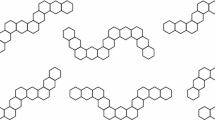Abstract
Let Q n and B n denote a quasi-polyomino chain with n squares and a quasi-hexagonal chain with n hexagons, respectively. In this paper, the authors establish a relation between the Wiener numbers of Q n and \( B_n :W(Q_n ) = \tfrac{1} {4}[W(B_n ) - \tfrac{8} {3}n^3 + \tfrac{{14}} {3}n + 3] \). And the extremal quasi-polyomino chains with respect to the Wiener number are determined. Furthermore, several classes of polyomino chains with large Wiener numbers are ordered.
Similar content being viewed by others
References
I. Gutman and S. Klavžar, Relations between Wiener numbers of benzenoid hydrocarbons and phenylenes, ACH-Models in Chemistry, 1998, 135(1/2): 45–55.
S. Klavžar, I. Gutman, and B. Mohar, Labeling of benzenoid systems which reflects the vertexdistance relations, J. Chem. Inf. Comput. Sci., 1995, 35: 590–593.
Ljiljana Pavloviĉ and Ivan Gutman, Wiener numbers of Phenylenes: An exact result, J. Chem. Inf. Comput. Sci., 1997, 37: 355–358.
L. Z. Zhang and F. J. Zhang, Extremal hexagonal chains concerning k-matchings and k-independent sets, Journal of Mathematical Chemistry, 2000, 27(4): 319–329.
Y. Q. Zeng and F. J. Zhang, Extremal polyomino chains on k-matchings and k-independent sets, J. Math. Chem., 2006.
I. Gutman and O. E. Polansky, Mathematical Concepts in Organic Chemistry, Speinger, Berlin, 1986.
F. Buckley and F. Harary, Distance in Graphs, Addison-Wesley, Redwood, 1990.
I. Gutman, Calculating the Wiener numbers of benzenoid hydrocarbons: Two theorems, Chem. Phys. Lett., 1987, 136: 134–136.
I. Gutman and O. E. Polansky, Wiener numbers of polyacenes and related benzenoid molecules, Commun. Math. Chem., 1986, 20: 115–123.
A. A. Dobrynin, A simple formula for the calculation of the Wiener index of hexagonal chains, Comput. Chem., 1999, 23(1): 43–48.
L. Q. Xu and X. F. Guo, Catacondensed hexagonal systems with large Wiener numbers, Math. Commun. Math. Comput. Chem., 2006, 55: 137–158.
I. Gutman, J. W. Kenedy, and L. V. Quintas, Wiener numbers of random benzenoid chains, Chem. Phys. Lett., 1990, 173: 403–408.
A. A. Dobrynin and I. Gutman, The average Wiener index of hexagonal chains, Comput. Chem., 1999, 23: 571–576.
A. A. Dobrynin, I. Gutman, S. Klavžar, and P. Žigert, Wiener index of hexagonal systems, Acta Appl. Math., 2002, 72: 247–294.
I. Gutman, Topological properties of Benzenoid systems, Topics. Curr. Chem., 1992, 162: 1–28.
Author information
Authors and Affiliations
Corresponding author
Additional information
This research is supported by the Natural Science Foundation of China under Grant No. 10371102.
Rights and permissions
About this article
Cite this article
Xie, M., Zhang, F. Relation between wiener numbers of quasi-hexagonal chains and quasi-polyomino chains. J Syst Sci Complex 23, 873–882 (2010). https://doi.org/10.1007/s11424-010-7024-1
Received:
Revised:
Published:
Issue Date:
DOI: https://doi.org/10.1007/s11424-010-7024-1




